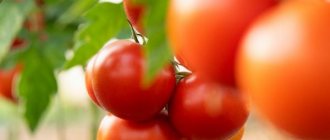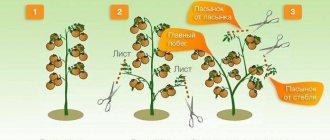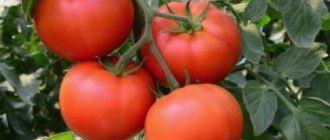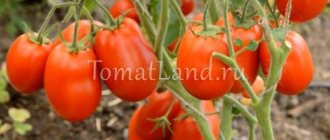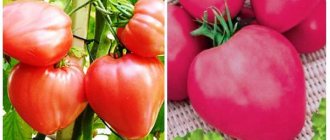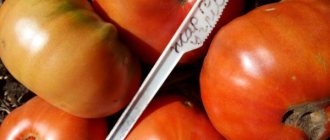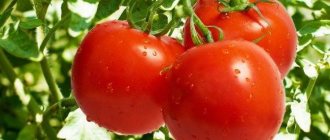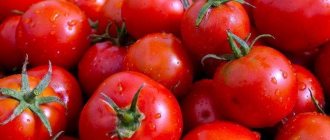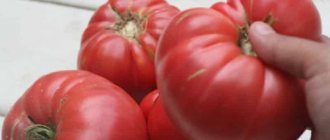Diseases and pests
Being a hybrid, the Dobry f1 tomato has increased resistance to many diseases - fusarium, tobacco mosaic virus. However, like all tomatoes, it is susceptible to other diseases, including late blight. Fitosporin or treatment with copper-containing preparations are used as a preventative measure to combat it.
To reduce the likelihood of infections in the greenhouse, it is recommended to carry out the following treatment every autumn:
- Clear the greenhouse area of plant debris.
- Disinfect the walls, frame of the greenhouse, and all auxiliary equipment with a solution of laundry soap.
- Treat the soil in the greenhouse with biological products - “Fitosporin”, “Shine -1” or chemicals - potassium permarganate, Bordeaux mixture.
- Treat the soil with lime and dolomite flour.
- Sow herbs – mustard, phacelia.
Carrying out these measures in the fall will reduce the number of harmful bacteria that actively reproduce in favorable conditions. Tilling the soil will also help in the fight against pest larvae inhabiting the greenhouse.
Tomatoes are affected by the following pests: slugs, spider mites, and Colorado potato beetles. To combat them when they appear en masse, there are many chemicals, but usually gardeners prefer folk remedies - infusions of dandelion, garlic, hot pepper.
Agricultural technology
Seed preparation
Tomato Goose egg
Not all seeds of this hybrid have pre-sowing preparation. When purchasing branded seeds, you need to read what is written on the package. Sometimes producers themselves prepare seeds for sowing. These seeds will cost more.
If the seeds have not undergone pre-sowing preparation, you need to do this yourself. To obtain disease-resistant seedlings, seeds placed in a cloth bag are treated for 20 minutes in an aqueous solution (1 gram of crystals per 1 glass of water) of potassium permanganate, and after the procedure the seeds are washed.
Wash Nuno tomato seeds
The next type of treatment is soaking in solutions of biological products that improve germination. You can take note of such drugs as Epin and Zircon. Soaking time is from 4 to 6 hours. Before sowing, you can harden the seeds by placing them in a warm place for a day, and then in a cold place for a couple of days.
Preparing seedlings
Planting of seeds is carried out in prepared containers with a soil mixture, which includes soil, humus and ash. The seeds are buried 1.5 cm into the soil at a distance of 2 centimeters from each other. The containers are covered with film or glass to create a greenhouse effect and accelerate seed germination. The room temperature should not be lower than 24°C. The condition of the top layer of soil should be monitored. You need to moisten the soil using a spray bottle using the drip method.
With the appearance of the third leaf on the plants, the seedlings are dropped one at a time into plastic cups. In order to better develop the root system, the main root is pinched during the dive.
The seedlings will grow in the cups for another month before being planted in the greenhouse. At this time, the plants need to be watered and fed with a solution of nitrophoska (15 grams of substance per bucket of water). A week before transplanting into the greenhouse, it is recommended to spray the bushes with boric acid.
Appearance of seedlings
Greenhouse preparation
The greenhouse is disinfected before tomatoes are planted. Wooden structures are fumigated with sulfur, and greenhouses with a metal frame are sprayed with a bleach solution. The soil is changed every five years. The soil in the greenhouse is disinfected with Bordeaux mixture.
Planting seedlings in a greenhouse
Before planting seedlings, you need to add granular complex fertilizers to the soil. They gradually open up in the soil, feeding the roots of the young plant. Planting young plants in the soil of a greenhouse is simple:
- Two weeks before planting, the seedlings are brought into the greenhouse for acclimatization;
- Holes 15 cm deep are made at a distance of 50 cm from each other;
- Complex fertilizers are laid out at the bottom of the hole, which the plant will need in the first stages of its growth. These are nitrogen, potassium and phosphorus;
- The seedlings are deepened to the first leaf slightly at an angle so that lateral roots begin to form;
- The earth is compacted;
- Supports are installed, or twine is pulled from a peg installed near the plant to the crossbar of the greenhouse. The growing plant will be attached to it.
Advantages and disadvantages
A tomato of this variety usually begins to bear fruit somewhat later than most of its counterparts, but its positive qualities should be noted:
- High yield.
- Extended fruiting period.
- Resistance to diseases - fusarium and tobacco mosaic virus.
- Possibility of long-term storage of fruits.
The “Good f1” tomato, judging by the reviews and photos of plants offered by those who planted it in a greenhouse, can bear fruit for a long time, and the shelf life of ripe fruits reaches 30 days.
Unfortunately, late fruiting in the absence of a greenhouse is a disadvantage, since in open ground the tomato does not have time to produce a full harvest.
Some summer residents also consider the disadvantages of the need to spend time on pinching and shaping plants in the greenhouse.
Care
Feeding
Tomato Em Champion: characteristics and description of the variety
After planting the plants in the greenhouse, you need to fertilize them once every 10 days with complex fertilizers. Their content of nitrogen, phosphorus and potassium should be equal. You can fertilize the stem with these fertilizers dissolved in water. You can carry out foliar feeding by spraying the leaves with a 0.2% solution. It does not depend on what kind of feeding: root or foliar, it is done once every 10 days. They can be alternated. Carry out foliar feeding in the evening hours so that the sun's rays do not burn wet leaves.
Note! If spotting appears on the leaf, you should fertilize it with calcium. If the foliage is pale, this indicates a lack of nitrogen. Plant nutrition affects productivity.
Stepsoning
Hybrid Dobry is a tall plant that needs special care. Initially, the plant forms into one stem. Lateral branches and stepsons are removed, allowing the formation of clusters with fruits on the main stem. When pinching, excess leaves that interfere with normal air circulation are also removed.
The leaves need to be removed after the fruits begin to appear on the first cluster from the bottom. Only in this case can you remove the leaves to this cluster with fruits. The upper leaves are not removed, they feed the lower fruits.
As soon as the fruits have filled, you can remove the next leaves located above the cluster until the next one, which begins to fill. The procedure is repeated. In August-September the stem will be almost bare. The leaves remain only at the top.
Growing tomatoes
Garter
Dobry tomato bushes require constant staking on a trellis as they grow. It is important for caring for tomatoes to timely ventilate the greenhouse so that there is no waterlogging, which negatively affects the development of the bush. The greenhouse must have a constant flow of air and ventilation through doors located on both sides.
Watering and temperature conditions
Tomatoes like the roots to have constant moisture, while the foliage likes a dry climate. Therefore, certain moisture and temperature parameters in the greenhouse must be observed. At night the temperature should be 16-18°C, during the day - up to 25-27°C. If the temperature is higher and the greenhouse is not ventilated, the pollen clumps together or even dries out on the stigma, as a result, pollination will not occur. That is, when gardeners observe that the brush has bloomed, but only 2-3 fruits have formed, a possible reason is the high temperature in the greenhouse.
Advice: Gardeners use mulch to retain moisture in the ground and reduce watering. Dried grass or sawdust is used as mulch.
Features of cultivation
To get a bountiful harvest of Dobry f1 tomatoes, it is better to grow the seedlings yourself, taking into account the following rules.
Carry out pre-sowing seed treatment:
- For disinfection, use a solution of potassium permarganate, hold for 20 minutes, then rinse.
- To improve germination, soak in growth stimulants such as Epin, Zircon for 6 hours.
The soil for tomato seedlings is prepared light and loose, from a mixture of garden soil, compost and ash. If the soil in the garden is clayey and heavy, add peat. Alternatively, you can use coconut substrate.
Garden soil for seedlings must undergo pre-treatment; for disinfection, it must be calcined in the oven or frozen.
Tomato Dobry
Description and characteristics of tomato Dobry F1, reviews, photos
Mid-season, indeterminate, disease-resistant tomato hybrid for growing in greenhouses. The bush is 1.6-1.8 meters high and requires tying to a support and pinching. The manufacturer recommends forming the plant into 1 stem, removing all side shoots (stepchildren).
The leaves of this tomato are large and dark green. The inflorescence is simple.
Basic qualities of fruits
The fruits are flat-round, smooth, dense, red in color at maturity, weighing 150-170 grams, fleshy, good (for a hybrid) taste. These tomatoes are suitable for fresh salads (especially if ripened on the bush), canning in pieces.
The hybrid is resistant to Fusarium wilt and TMV.
Originator : agricultural company Gavrish.
The Dobry F1 tomato is included in the State Register of the Russian Federation for growing under film covers on private farms.
Features of cultivation, planting and care
We recommend sowing seeds for seedlings 60-65 days before the intended planting in the ground. When planting seedlings in a permanent place, up to 4 plants are placed on 1 square meter of land.
Further care for tomatoes consists of pinching, removing weeds, timely watering and protecting plants from diseases and pests.
If you grew Dobry tomatoes, please write whether you liked them or not. What was the yield and taste of the fruits like under your climatic conditions? Briefly describe the advantages and disadvantages of this hybrid. Will you grow it again? If possible, attach a photo of your tomatoes to your comment. Thank you!
Your reviews of the Dobry tomato and additions to the description will help many gardeners evaluate this hybrid more objectively and decide whether it is worth planting or not.
Tomato Dobry
Early ripening varieties of tomatoes are always a delight, but summer does not end in July, after the mass harvest of tomatoes of these ripening periods. I want to get fresh tomatoes from the garden before the end of summer and in the autumn months. To satisfy consumer demand, breeders offer late-ripening hybrid varieties, such as the Dobry tomato variety.
Characteristic characteristics of the variety
The Dobry tomato variety is intended for cultivation in a greenhouse. This is a powerful indeterminate type (unlimited growth) plant, belongs to the group of tall tomatoes. The bush reaches a height of up to 2 meters, which requires mandatory tying to a support and forming the plant into one stem by pinching side shoots. This is the recommendation of breeders. The leaves of the plant are large and dark green in color.
Fruit
Tomato Dobry f1 has dense, rich red fruits, the shape of which is flat-round, and medium in size. Weight ranges from 140 to 170 grams. The pulp is fleshy and sweet. Fresh tomatoes are used in salads; tomatoes produce thick tomato juice due to the density of the fruit. Dobry tomatoes are suitable for canning and have the remarkable property of being easily stored and transported.
Maturation
Dobry belongs to the mid-late varieties. Ripening begins four months after sowing the seeds. That is why it is recommended to cultivate it in a greenhouse, since in the garden it will not have time to ripen before the cold weather. The brushes on the bushes form until October. Productivity is noted as high. From each bush, with good proper care, you can get up to five kilograms of selected sweet tomatoes or up to 10-13 kg from 1 square meter of area.
Characteristics and description of the tomato variety Dobry f1, its yield
First generation hybrids are bred to display the best parental qualities. Such is the Dobry tomato, obtained in the form of an indeterminate plant. It is especially suitable for growing under film covers.
Features of the hybrid
If you want to grow delicious tomatoes for summer salads, then the Dobry variety is perfect for this. The bushes of the plant are tall, reaching 160-180 centimeters. Large dark green leaves on long stems. The hybrid bears smooth, dense fruits that are light green when unripe and red when ripe. The tomatoes are flat-round in shape, weighing up to 170 grams. Tomatoes are one of the best in taste – sweet and meaty.
The collected fruits are used for preparing summer salads and canning in pieces. Tomatoes ripen 110-120 days after the first shoots appear.
The Dobry F1 tomato is suitable for growing indoors, as it does not have time to ripen outdoors. From ten to thirteen kilograms of juicy tomatoes are harvested from one square meter.
Belonging to the F1 generation, the hybrid is resistant to such dangerous tomato diseases as fusarium and viral mosaic.
The excellent characteristics of the vegetable plant contribute to the prevalence of the hybrid in gardeners' plots.
Rules for agricultural technology of tomatoes in greenhouses
The seedling method is a real opportunity to obtain high-quality Dobry tomatoes.
Growing seedlings
Tomato seeds are prepared in advance. The procedures will allow you to obtain seedlings that are resistant to many diseases. Having placed the seeds in a canvas bag, immerse them in a solution of potassium permanganate for twenty minutes. It is prepared by dissolving one gram of crystals in a glass of water.
The next step is to process the seed material in a nitrophoska solution for two hours. To harden, the seeds are first placed in heat for a day, then in the cold for two days.
Soil is poured into containers, moistened and compacted. Tomato seeds are laid out at a distance of two centimeters from each other, buried one and a half centimeters into the ground. It is better to place the tray in a well-lit place. To make the seeds hatch faster, cover the containers with plastic wrap.
The description of caring for seedlings includes the following actions:
- Watering should be done every seven or fourteen days, depending on the condition of the topsoil.
- Maintaining temperature conditions is important for seedlings. It will stretch out greatly if the air temperature is below sixteen to eighteen degrees in the first week, twenty in subsequent periods.
- As soon as three leaves appear, the seedlings are picked.
- After transplantation, it would be good to feed the seedlings with a solution of nitrophoska, dissolving fifteen grams of the substance in a bucket of water.
- A week before transferring the plants to the greenhouse, the bushes are sprayed with boric acid.
Whoever grew the seedlings correctly will receive good vegetable yields in the future.
Preparing the greenhouse for planting tomatoes
Any greenhouse structure is prepared for planting vegetables in the fall. The main procedure is disinfection of the premises. Wooden buildings are fumigated with sulfur. To do this, a mixture of sulfur and kerosene is placed on iron sheets and set on fire. Aphids for four days, sulfur will protect plants from pathogenic fungi and pests.
In greenhouses with a metal frame, a bleach solution is used to spray the surfaces inside.
The soil in the room is replaced with a new one every five years. Be sure to disinfect the soil mixture with Bordeaux mixture before planting the vegetable.
Since tomatoes are heat-loving plants, the soil must be heated from the inside. A layer of sawdust ten centimeters thick is poured under it, then compost – twenty centimeters thick.
Transfer rules
Seedlings are planted in well-heated greenhouses at the end of April, under film coverings - until mid-May.
The procedure for planting vegetables in a greenhouse is as follows:
- Make holes in the soil 15 centimeters deep.
- The seedlings are watered half an hour before planting in closed ground, and the long roots of the plant are shortened.
- Place the seedlings in the ground up to the first leaf. The elongated seedlings are slightly tilted, covering part of the stem with soil.
- The soil is compacted around the stem, and the bushes are sprayed with Bordeaux mixture (100 grams of substance per 10 liters of water).
